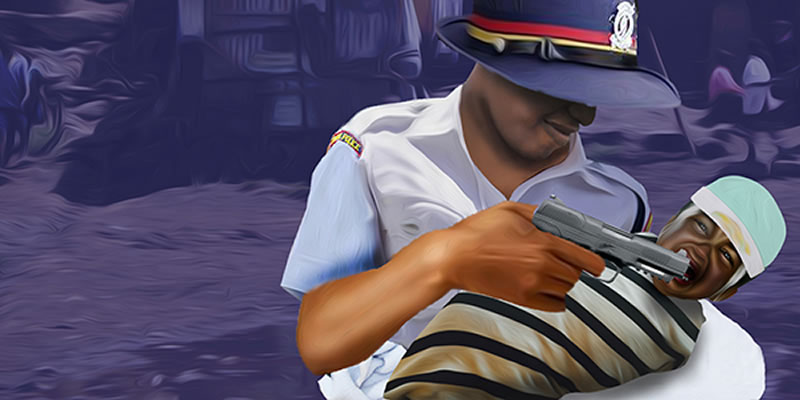‘The traveller whose name is not Annah remembers thinking about all the mothers she had seen on television, clutching old photographs, speaking of sons who never made it home. She wonders how it must have been for them – sitting, waiting, hoping that each knock on the door was from their son’s fist.’
These words from Ndinda Kioko in Sometime Before Maulidi seem to speak directly to the everyday trauma of families living in Nairobi settlements, where the police bullet informs much of the street talk and young men live in constant fear of death. Most do not live to see their children grow up.
Just the other day, a friend from Dandora called asking for help. Police had arrested him during a spontaneous demonstration by residents after yet another killing of two young men by police in broad daylight, and in plain view of many. Both murdered men had been rummaging at the dumping site to find sellable goods to make their daily living when they were shot dead. One of them was deaf. Though both deaths mattered, it was especially the murder of the deaf man that sparked outrage among residents. To them, he embodied ‘innocence,’ as one resident put it, and they all knew him as a kind soul who kept mostly to himself.
Mathare is just one of 158 urban settlements in Nairobi, and Nairobi is just one of many cities and towns in Kenya. This leads us to conclude that the total number of police killings per year in Kenya most likely puts us in the top 10 of the world
Our friend raised his voice during the demonstration and paid for it by spending a night at Buru Buru Police Station. The next day he told us that he had been severely beaten while in custody, and charged with ‘incitement.’ This shows both how young and poor men in Kenya have become automatically ‘criminals’ in the eyes of the police and the perils of speaking up against excessive use of force by the police.
Below, we discuss both the scale and scope of police killings in Mathare, and in Kenyan in general, and the dangers involved in speaking up for the rights of crime suspects.
At Least One Young Man Shot a Week
Shockingly, the murder of these two young men in Dandora last week by the police was not a first or a single event. Only a couple of days before this incident, we documented the police shootings of two young male students (from the Technical University of Kenya) in Mlango Kubwa (Mathare), which led to the death of one of them later that evening. And this incident, again, happened only two days after police shot and killed several young men in Kayole on April 20. In fact, such assassinations by the police have taken the lives of thousands of young and poor men over the past decade in Kenya.
To give an indication of this informed estimate, executions of young, poor and male crime suspects by the police have led to the death of at least one young man from Mathare, a Nairobi settlement, per week on average between January 2013 and December 2016. Put differently, over the past three years at least 156 poor young men in this settlement have been killed by a police bullet. Our data is not comprehensive, for it only reflects the cases we have been able to verify through multiple sources — a dangerous and arduous task in and of itself due to constant police harassment. It thus has to be emphasised that the actual death rate in Mathare as a result of a police bullet may be much, much higher.
Also, Mathare is just one of 158 urban settlements in Nairobi, and Nairobi is just one of many cities and towns in Kenya where such killings occur regularly. This leads us to conclude that the total number of police killings per year in Kenya most likely puts us in the top-ten of the world.
Who Are Killed by Police, and Why?
All families in Mathare have lost a loved one to a police bullet. This means that all families have lost a father, son, or brother, neighbour, nephew or grandchild. Alongside the incredible pain of losing a loved one, the economic impact cannot be understated. Many young men who were killed by police over the years took care of their extended families; including their often single mother, siblings, wives and young children. Their murders have thus left entire families in a situation of dire poverty.
Most of the cases we have documented over the years concern young and poor men between 13 and 25 years of age with no criminal record, many of whom have been shot by police during school holidays, while walking around with friends or just chatting with neighbours around the corner of their own homes. Some were executed in plain view and in broad daylight, others were taken to back alleys or shot under the cover of night-time.
Police killings in Kenya are generally committed by police officers from different police units and organisations. They form an integral part of policing in Mathare (and other urban settlements and particular rural regions in Kenya — such as North Eastern). The use of excessive force and executions should thus be considered a structural approach by the police in dealing with crime suspects (and terror suspects — but in this article we focus on crime suspects). The general narrative used to legitimise such killings is the threat these suspects allegedly pose to the officers in question, even if the suspects had no weapons on them and were shot in the back.
Police killings in Kenya are generally committed by police officers from different police units and organisations. They form an integral part of policing in Mathare
Also, the government, and by extension the police, often justify the shoot-to-kill policy by declaring it as an effective approach to curb crime in Mathare and other urban settlements, even if there is no evidence to substantiate such claims. On the contrary, crime has not gone down over the past decade. This line of thinking, however, frames such killings as an effective means of getting rid of active thieves and deterring emerging ones.
Lastly, the lack of public outcry over these killings tells us that the middle class seems to have bought into the legitimating narratives that implicate these young men as imminent threats to society at large and to police officers in particular. Hence, shooting poor young men who are suspected of being thieves is considered quite legitimate within the public domain. This is illustrated by the widespread support for the known police officer who was filmed killing two young male crime suspects in Eastleigh in front of a large crowd of onlookers on March 31.
Most of These Killings Are Unlawful
Legally, a ‘suspect’ is said to be a person thought to be guilty of a crime, and what exactly constitutes a crime is clearly stipulated in the Penal Code. In this sense, a crime has to be ongoing or to have been reported to the police by a witness. This means that the police either have to be present in the course of an ongoing criminal act or in the course of investigating the crime to have acquired enough evidence to arrest the person thought to have committed it. The Kenya Police Service have the duty to maintain law and order, investigate crime and apprehend offenders. In doing so, they are allowed to use force, but only to directly protect themselves and/or the lives of others.
All actions by police that result in injury to or death of a person have to be reported, a requirement of the current Kenya Police Service Act. Failure to do so is considered an offence, yet rarely are these events reported by police officers to their superiors
The emphasis here is on the term ‘directly’, and thus excludes killing suspects that do not instantly threaten the lives of police officers or bystanders. Our extensive documentation, however, reveals that most killings by police occur in situations where the only one under threat is the alleged crime suspect. This is constitutionally deemed illegal, since Article 48-51 of our Constitution guarantees every person the right to due process. According to our research, the majority of police killings can therefore be considered extra-judicial executions (EJEs).
Lack of Official Investigation and Follow-Up
All actions by police that result in injury to or death of a person have to be reported, a requirement of the current Kenya Police Service Act. Failure to do so is considered an offence, yet rarely are these events reported by police officers to their superiors. The said Act further states that the OCS shall also report any use of force by police that causes injury or death to the Independent Policing and Oversight Authority (IPOA). This government body is mandated to investigate all cases of alleged police killings, whether brought to them by the OCS or by human rights defenders like us, and work towards prosecution accordingly. Failure to do so is also considered an offence, yet IPOA rarely follow -up on either.
From one of the first cases that was brought to IPOA in 2012 to the most recent one (of the student in Mlango Kubwa), IPOA is yet to live up to its mandate. Furthermore, the Kenya National Commission for Human Rights (KNCHR) is mandated to investigate any accusation of human-rights violations by government officials, such as police officers. The Ombudsman is also mandated to keep the powers of government officials such as police officers in check through investigations and sanctions. All these are government institutions that are paid for with our tax money to provide all Kenyan citizens with oversight of police and protect our civil rights as citizens. Until now, we as grassroots human-rights defenders have not received much support from them in our continuous quest for justice.
Human-Rights Work on the Frontline
Most cases of human-rights violations are reported to community centres in urban settlements that have taken on the herculean task of confronting social injustice through documentation, referral and advocacy against normalised violence meted out on poor people’s bodies. The Mathare Social Justice Centre (MSJC) is such a centre, and cases of rights violation by police are brought to us on a daily basis. Sadly, all these cases pile up in books and documentation forms on the other side of town; cases we carefully document, often with great risk to our own lives. We duly continue to try to report all these cases to IPOA, KNHRC and the Ombudsman by sitting in empty hallways for hours on end, days even, and by walking from one office to the other, patiently pacing from one side of the city to the other on foot.
We still hope we can move these bodies to action, to live up to their mandates and start helping us systematically protect the civil rights of Kenyan citizens. That they can be prodded into action was illustrated by their demonstrations against extrajudicial killings after the bodies of ‘the Mavoko Three’ were discovered last year, even if these actions were fleeting. Yet, their involvement was brought back momentarily by the recent video of the aforementioned ‘Eastleigh Killings’ that went viral on social media, but the sheer fact that it takes a high-profile case or social media hype to draw their attention and prompt them into actions does not give us great confidence in their commitment to structurally fight this grave social injustice side by side with us.
We duly continue to try to report all these cases to IPOA, KNHRC and the Ombudsman by sitting in empty hallways for hours on end, days even, and by walking from one office to the other, patiently pacing from one side of the city to the other on foot
For us, this is a daily reality. It concerns our brothers, friends and fathers. Our children. We do not have the luxury to look away and not act, for we are losing a generation of our own young men … yet again. Despite fear for our own lives, this drives us to continue to document and follow up cases of police killings in Mathare. Just weeks ago, one of our campaign leaders fighting police brutality was stuffed into the boot of a notorious white Probox by well-known police officers, where they mentally tortured and threatened him for three hours until they released him. What will happen next time?







